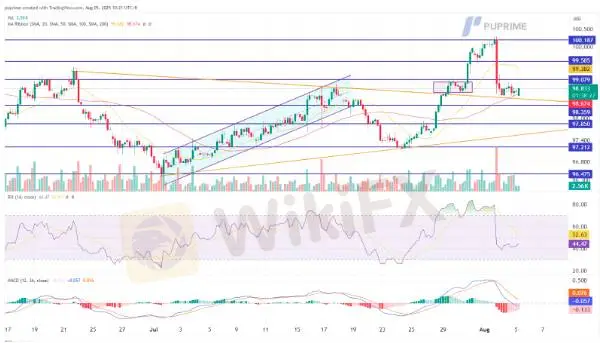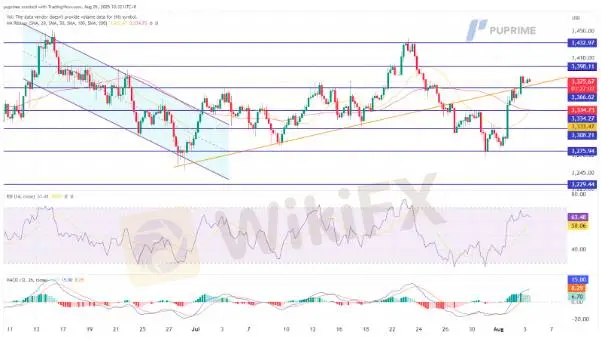简体中文
繁體中文
English
Pусский
日本語
ภาษาไทย
Tiếng Việt
Bahasa Indonesia
Español
हिन्दी
Filippiiniläinen
Français
Deutsch
Português
Türkçe
한국어
العربية
Dollar Falters Amid Political Turmoil and Trade Uncertainty; Gold Surges
Abstract:Key Takeaways:The greenback slipped after a weaker-than-expected NFP and Trumps abrupt firing of the BLS head. The dollar index remained flat as traders await U.S. PMI data for clearer signals on econ
Key Takeaways:
The greenback slipped after a weaker-than-expected NFP and Trumps abrupt firing of the BLS head.
The dollar index remained flat as traders await U.S. PMI data for clearer signals on economic momentum and potential FX volatility.
Heightened tariff threats and sanction risks fueled demand for gold, sending spot prices above weekly high.
Market Summary:
The U.S. dollar came under pressure last Friday following a disappointing Nonfarm Payrolls (NFP) report, which fell short of market expectations. The selloff deepened after President Trump dismissed the head of the Bureau of Labor Statistics, accusing the agency of incompetence and misrepresenting the nations economic health. The abrupt move added a layer of political risk that further undermined confidence in the greenback.
The dollar index struggled for direction at the start of the week, trading flat as investors awaited the upcoming U.S. PMI readings, which could offer fresh signals on the health of the economy and provide catalysts for renewed volatility in the currency markets.
Beyond domestic uncertainty, traders are also closely monitoring escalating geopolitical tensions. The White House is reportedly preparing to impose steeper tariffs on India amid a deepening rift with Russia. Washington is also threatening secondary sanctions on nations that continue purchasing Russian energy—raising fears of a broader trade conflict involving multiple countries.
The growing unease triggered a strong flight to safety. Traditional haven asset gold surged, with spot prices climbing above the $3,380 level—marking a new weekly high—as investors sought shelter from both political instability and global trade risks.
Technical Analysis

DXY, H4:
The U.S. Dollar Index suffered a sharp decline of more than 1.5% in the early session, retreating toward a previously established liquidity zone. After the initial drop, the index has stabilized, trading sideways as market participants reassess the macro and political landscape.
Despite the downturn, the index remains above the critical 68.2% Fibonacci retracement level at 98.37, indicating it is still holding within a broader bullish structure. A successful rebound from this level could signal the potential for a bullish trend reversal.
However, technical indicators point to growing downside pressure. The Relative Strength Index (RSI) has dipped below the midpoint, reflecting a bearish bias, while the MACD has fallen beneath the zero line and is widening, underscoring intensifying bearish momentum.
Traders will be closely watching whether the dollar can reclaim upward momentum from this support zone, or if sustained weakness will invalidate the broader uptrend.
Resistance level: 99.10, 99.60
Support level: 98.70, 97.85

XAUUSD, H4:
Gold extended its rebound from monthly lows, surging over 3% in the past two sessions as bullish momentum gained traction. After an initial spike, the yellow metal consolidated near the $3,355 mark before advancing another 0.7% in the latest session—underscoring persistent buying interest.
Technical indicators reinforce the bullish outlook. The Relative Strength Index (RSI) has surged toward overbought territory, while the MACD has formed a bullish crossover below the zero line and is now diverging higher, having broken above the neutral level. This suggests a firm acceleration in upward momentum for the precious metal.
Should bullish pressure persist, gold may be poised for further gains in the sessions ahead.
Resistance level: 3398.10, 3433.00
Support level: 3366.00, 3335.00
Disclaimer:
The views in this article only represent the author's personal views, and do not constitute investment advice on this platform. This platform does not guarantee the accuracy, completeness and timeliness of the information in the article, and will not be liable for any loss caused by the use of or reliance on the information in the article.
WikiFX Broker
Latest News
XS.com Broker Partnership Expands Liquidity with Centroid Integration
EC Markets: A Closer Look at Its Licenses
Housewife Scammed of RM68,242 in Online Investment Scam
ASIC Regulated Forex Brokers: Why Licensing Still Matters in 2025
From Charts to Profits: Unleashing the Power of Forex Trading Tools
FCA Publishes New Warning List! Check It Now to Stay Safe
Forex Hedging Strategies - Calming You Amid Market Chaos
LSEG Announces £1 Billion Share Buyback Program
Ultima Markets enters the UK and gains the FCA license
SEC Lawsuit Targets Real Estate Fraud Scheme by Joseph Nantomah
Currency Calculator


